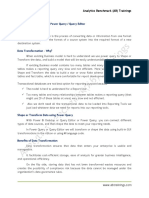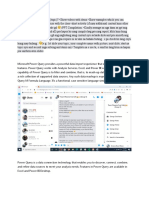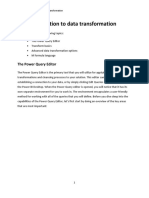0% found this document useful (0 votes)
128 views8 pagesIntroduction To Power Query
Power Query is a data transformation and preparation tool that can extract, transform, and load (ETL) data. It has a graphical interface for accessing data sources and a Power Query Editor for applying transformations using its built-in functions or through writing M code. Power Query can be used in Microsoft products like Excel, Power BI, and SQL Server Analysis Services to connect to various data sources and define repeatable queries to retrieve and transform data.
Uploaded by
Joy MalikCopyright
© © All Rights Reserved
We take content rights seriously. If you suspect this is your content, claim it here.
Available Formats
Download as PDF, TXT or read online on Scribd
0% found this document useful (0 votes)
128 views8 pagesIntroduction To Power Query
Power Query is a data transformation and preparation tool that can extract, transform, and load (ETL) data. It has a graphical interface for accessing data sources and a Power Query Editor for applying transformations using its built-in functions or through writing M code. Power Query can be used in Microsoft products like Excel, Power BI, and SQL Server Analysis Services to connect to various data sources and define repeatable queries to retrieve and transform data.
Uploaded by
Joy MalikCopyright
© © All Rights Reserved
We take content rights seriously. If you suspect this is your content, claim it here.
Available Formats
Download as PDF, TXT or read online on Scribd
/ 8


























































